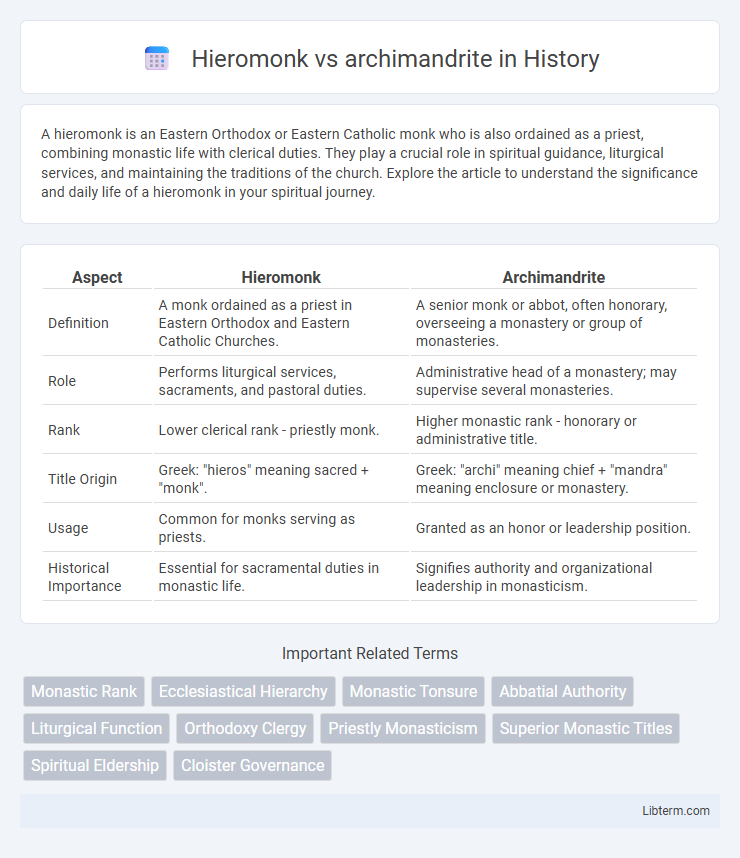A hieromonk is an Eastern Orthodox or Eastern Catholic monk who is also ordained as a priest, combining monastic life with clerical duties. They play a crucial role in spiritual guidance, liturgical services, and maintaining the traditions of the church. Explore the article to understand the significance and daily life of a hieromonk in your spiritual journey.
Table of Comparison
| Aspect | Hieromonk | Archimandrite |
|---|---|---|
| Definition | A monk ordained as a priest in Eastern Orthodox and Eastern Catholic Churches. | A senior monk or abbot, often honorary, overseeing a monastery or group of monasteries. |
| Role | Performs liturgical services, sacraments, and pastoral duties. | Administrative head of a monastery; may supervise several monasteries. |
| Rank | Lower clerical rank - priestly monk. | Higher monastic rank - honorary or administrative title. |
| Title Origin | Greek: "hieros" meaning sacred + "monk". | Greek: "archi" meaning chief + "mandra" meaning enclosure or monastery. |
| Usage | Common for monks serving as priests. | Granted as an honor or leadership position. |
| Historical Importance | Essential for sacramental duties in monastic life. | Signifies authority and organizational leadership in monasticism. |
Understanding Hieromonk: Definition and Role
Hieromonk refers to a monk who has been ordained as a priest within the Orthodox Church, combining monastic life with priestly duties such as administering sacraments and leading liturgical services. The role of a hieromonk involves both spiritual guidance and pastoral care, serving the monastic community and lay faithful alike. Unlike an archimandrite, who holds a senior monastic rank often responsible for overseeing multiple monasteries or a large monastic community, a hieromonk typically focuses on the spiritual practice and sacramental responsibilities within a single monastic setting.
Who Is an Archimandrite? Key Responsibilities
An Archimandrite is a senior monastic rank in Eastern Orthodox Christianity, often bestowed upon a hieromonk who has demonstrated exceptional leadership and spiritual maturity. Key responsibilities include overseeing multiple monasteries, guiding monks in their religious duties, and representing the monastery within the ecclesiastical hierarchy. Archimandrites play a vital role in maintaining monastic discipline, liturgical standards, and fostering spiritual growth within their jurisdiction.
Hieromonk vs Archimandrite: Core Differences
Hieromonk and archimandrite are both monastic ranks in Eastern Orthodox Christianity, with key distinctions in authority and responsibilities. A hieromonk is a monk who has been ordained as a priest, serving primarily in liturgical and sacramental roles within a monastery. In contrast, an archimandrite holds a higher rank, often overseeing multiple monasteries or acting as an abbot, with greater administrative duties and honorific status in the church hierarchy.
Historical Origins of Hieromonks and Archimandrites
Hieromonks historically emerged as ordained monks who also perform priestly duties within Eastern Orthodox and Eastern Catholic traditions, combining monasticism with clerical responsibilities. Archimandrites originated as senior monastic leaders, often overseeing multiple monasteries or a large monastery, reflecting a higher ecclesiastical rank introduced in Byzantine Christian monasticism. The title Archimandrite derives from the Greek words "archi" (chief) and "mandra" (enclosure or monastery), signifying authoritative governance established in the early medieval period.
Hierarchical Position in the Eastern Orthodox Church
Hieromonk is a monk who has been ordained to the priesthood within the Eastern Orthodox Church, serving at the basic clerical level. An archimandrite holds a higher hierarchical position, often acting as the head of a monastery or overseeing several monasteries, and is considered a senior monastic rank. The archimandrite rank is usually granted to experienced hieromonks for distinguished service or leadership roles within the church's monastic community.
Process of Ordination: Hieromonk and Archimandrite
The process of ordination for a Hieromonk involves the initial tonsure as a monk followed by ordination to the priesthood, granting sacramental authority within the Orthodox Church. An Archimandrite typically undergoes a subsequent elevation granted by a bishop, signifying a higher monastic rank and administrative responsibility, often awarded to experienced Hieromonks. This hierarchical advancement reflects both spiritual maturity and service leadership within monastic communities.
Daily Duties: Comparing Clerical Functions
Hieromonks primarily engage in daily liturgical services, prayer, and monastic duties within their monastery, emphasizing pastoral care and spiritual guidance. Archimandrites oversee broader administrative responsibilities, supervising multiple monasteries or significant ecclesiastical institutions while maintaining active clerical functions. Both roles require deep theological knowledge, but archimandrites balance spiritual leadership with organizational management more extensively than hieromonks.
Monastic Life and Leadership Roles
Hieromonks are monks who have received ordination as priests, focusing on liturgical duties and spiritual guidance within the monastic community, whereas archimandrites hold a higher ecclesiastical rank often bestowed upon experienced hieromonks entrusted with administrative leadership and oversight of multiple monastic institutions. The archimandrite role involves greater responsibility for governance, disciplinary authority, and representation of the monastery to the broader church hierarchy. Monastic life for hieromonks centers on prayer, service, and community life, while archimandrites balance these spiritual practices with significant organizational leadership functions.
Symbolism and Vestments: Signs of Rank
Hieromonks wear a simple black cassock and a klobuk, symbolizing their commitment to monastic life and priestly duties without episcopal authority. Archimandrites don more elaborate vestments, including a mitre and an engolpion, reflecting their higher ecclesiastical rank and administrative leadership within the monastery or diocese. The distinctive ornamentation of an archimandrite's vestments serves as a visible sign of honor and spiritual authority, distinguishing them clearly from hieromonks.
Influence on Orthodox Spiritual Tradition
Hieromonk and archimandrite titles signify different levels of monastic hierarchy within the Orthodox Church, where hieromonks are monk-priests devoted to pastoral duties and liturgical services influencing local spiritual life. Archimandrites hold higher authority, often overseeing several monasteries or serving in administrative roles, thus shaping broader Orthodox spiritual traditions through leadership and theological guidance. The influence of hieromonks is more localized and liturgically centered, while archimandrites impact the continuity and governance of monastic spirituality within Orthodox communities.
Hieromonk Infographic

 libterm.com
libterm.com